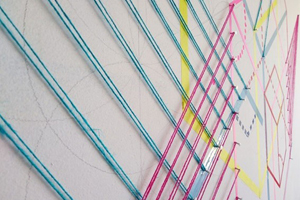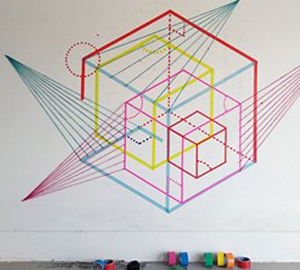Science Art Walk
Background and rationale

Designed by artist Kagiso Pat Mautloa, a thirteen-metre wall mosaic piece installed at UFS, produced by the Spier Architectural Arts Cape Town
Established in 1873, the University of South Africa's institutional vision encompasses the agenda for transformation that is summarised as: “Towards the African University shaping futures in the service of humanity”. This expresses the desire of the institution to connect (with society) and to shape – the latter being the embodiment of artistic expression. The institution has pledged to promote community development through the use of staff knowledge and skills to enhance the research and teaching skills of students and staff, and to be of benefit to the wider society. As Africa's leading open distance learning institution, Unisa offers internationally accredited qualifications and has world-class resources that inspire learners to create meaningful futures on their own terms.
Unisa approved an Environmental Sustainability Policy in 2012 and adopted the Green Economy and Sustainability Engagement Model (GESEM) in 2013. This was followed by the establishment of the Sustainability Office later that same year and the development of a number of policies and position statements, which support the Sustainability Framework.
Unisa has done groundbreaking work on sustainability matters, including becoming a signatory to the United Nations Global Compact (UNGC) in 2007, establishing both the Exxaro Chair in Business and Climate Change and the Sustainability Office, developing policy documents and master plans and identifying conservation as one of the 11Cs.
The university has won numerous national awards for its environmental sustainability initiatives and has also taken the lead in the establishment of a (Environmental) Sustainability Community of Practice under the auspices of Universities South Africa (USAf).
Unisa Florida Campus is the science hub of Unisa’s science-related programmes. Unisa has made science a priority and aims to grow research capacity and support research activities in the fields of science, engineering, technology, agriculture and environmental sciences through the colleges located on its Science Campus.
The most beautiful thing we can experience is the mysterious. It is the source of all true art and science. – Albert Einstein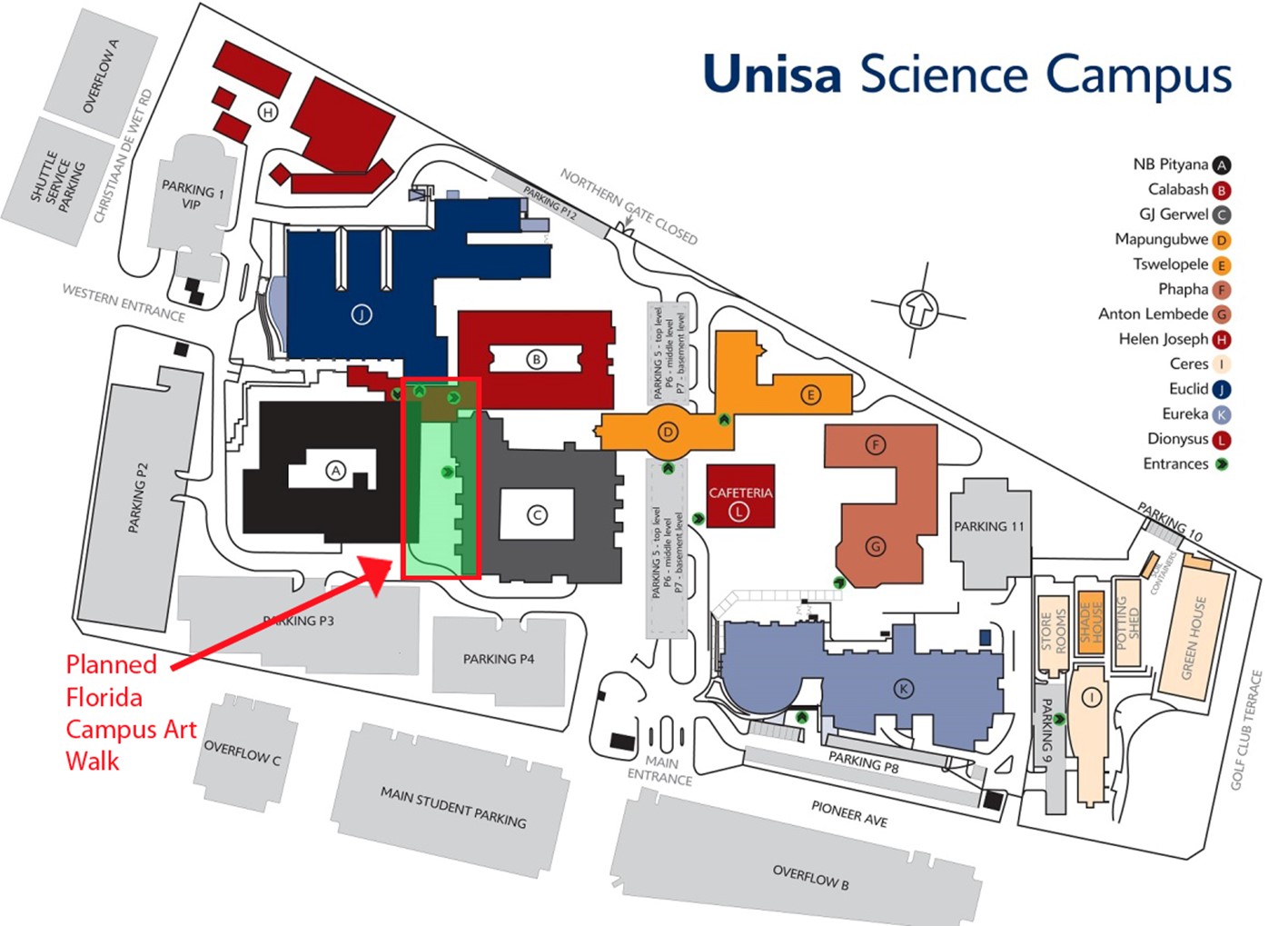
The Unisa Science Campus in Florida has in less than 10 years been transformed from a campus with rolling lawns and tree-lined walkways to a highly built-up campus with few wind-down and relaxation areas for staff and students alike. The specific area on campus ear-marked for this intervention includes three main buildings: the Calabash, NB Pityana and GJ Gerwel blocks, with the latter two having been named after political and human rights activists who played important roles in the transformation of South Africa and the higher education sector in particular. The buildings are adjacent to one another and separated by a walkway that leads to the engineering laboratories. This walkway is the site identified for this intervention with public sculptures and other refurbishments (such as mosaic work and artistically-designed benches) embodying the sustainability principles of Reduce Reuse Recycle.
Mosaic examples:
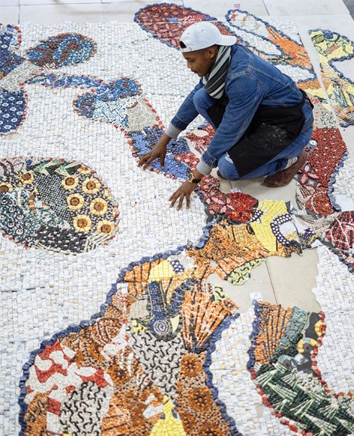 |
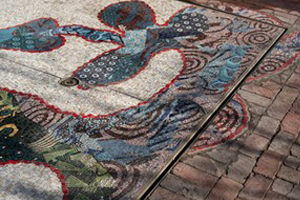 |
| Lizette Chirrime, Uthomi. Large scale mosaic at Spier. Image available at: https://visi.co.za/large-scale-mosaic-by-lizette-chirrime-at-spier/ | |
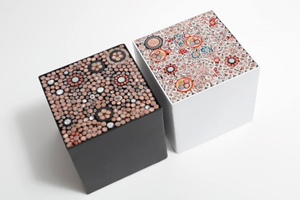 |
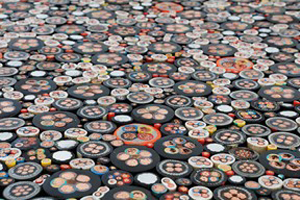 |
|
Ingrid Bolton, Copper cubed I, 2017. Metal box, various cables. Courtesy of the artist & Berman Contemporary. Images available at https://artafricamagazine.org/ingrid-bolton-berman-contemporary-investec-cape-town-art-fair-2018/ |
|
The intervention with public art aims to transform what was once a tree-lined walkway (but is currently an uninvitingly bare area) leading to four of the major buildings on the campus, into an open air art walk that provides opportunities to pause, play and be revived. The idea is to put out a call to all Unisa staff and Art Department alumni and current students to submit proposals for works that can be included as part of this intervention, with an emphasis on the use of recycled materials in the artworks. Inter-disciplinary collaborations on the works will be strongly encouraged.
It is the supreme art of the teacher to awaken joy in creative expression and knowledge. – Albert Einstein
Installation examples:
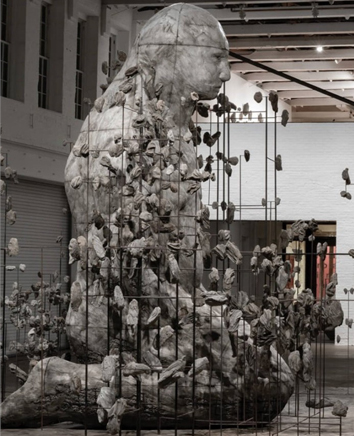 |
|
| Ledele Moe, Lament (Exploded Geographies), 2018, Biennale De Dakar, Dakar, Senegal . Images available at https://www.ledellemoe.com/news | Keneilwe Mokoena https://www.art.co.za/keneilwemokoena/artworks.php |
Fibreglass sculptures:
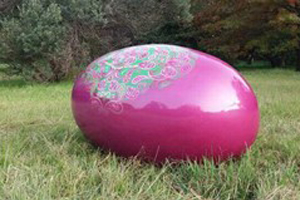 |
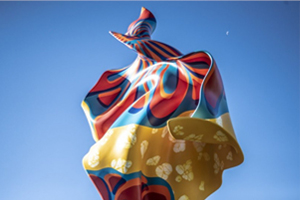 |
|
Manu Manjeesh Laal, Rebirth (2016). Fibreglass, Automotive Paint, Vinyl. Installation at Nirox Sculpture Festival (Unisa alumni) |
Yinka Shonibare, CBE Wind Sculpture SG III (2018) Steel armature with hand painted fibreglass resin cast 700 x 254 x 200 cm. Norval Foundation |
As a further development, works already in the Unisa Art Gallery collection will be considered for placement in the area on permanent loan as well as the purchase of works through the Unisa Art Gallery for inclusion in the exhibition. To this end, this project has negotiated and reached an agreement with the Unisa Gallery to include this initiative as an item on their acquisition meeting’s agenda for consideration.
The project has also obtained permission from the owner of the artworks commissioned for the abandoned Eternal Flame project for these works to be repurposed for the Science Campus Art Walk project. The materials used for these works (steel and wood) will be made available to artists for use in new works for the project. See the images below.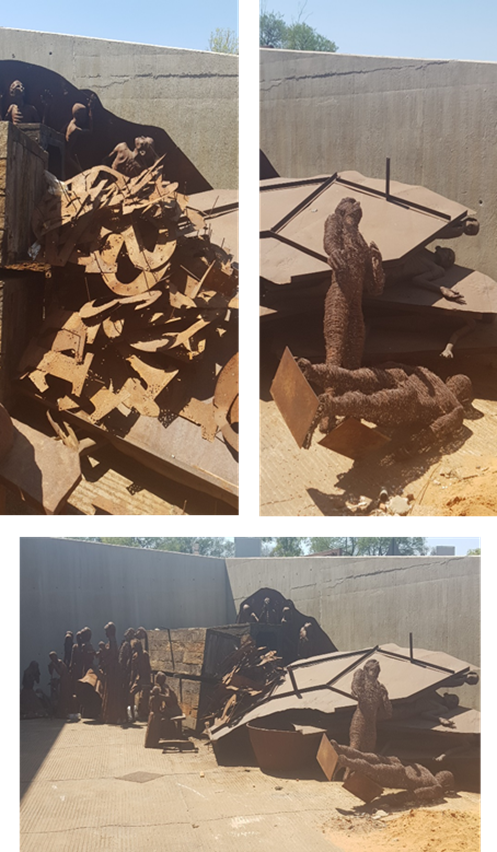
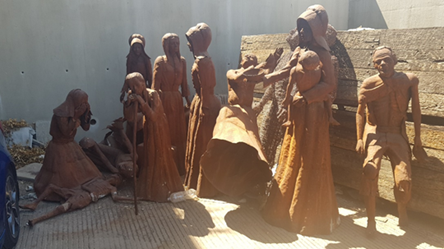
Last modified: Sat Jul 29 02:30:47 SAST 2023
